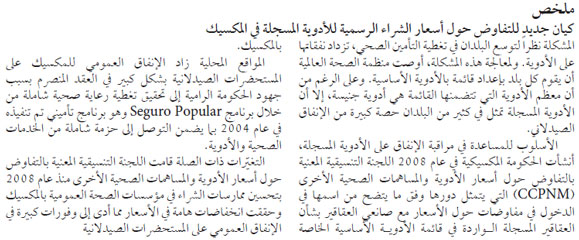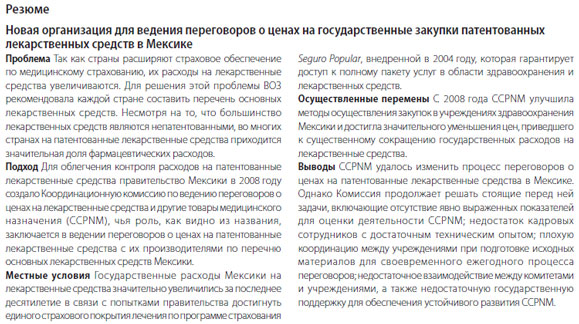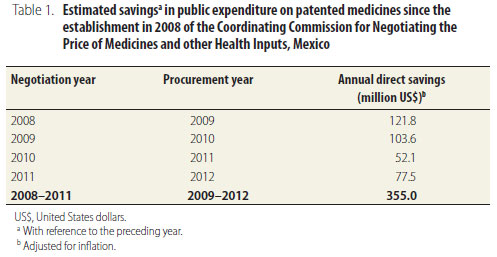LESSONS FROM THE FIELD
A new entity for the negotiation of public procurement prices for patented medicines in Mexico
Une nouvelle entité pour la négociation des prix publics d'achat des médicaments brevetés au Mexique
Nueva entidad para negociar los precios de adquisición pública de los medicamentos patentados en México
Octavio Gómez-DantésI,*; Veronika J WirtzI; Michael R ReichII; Paulina TerrazasIII; Maki OrtizIV
INational Institute of Public Health, Avenida Universidad 655, Colonia Santa María, 62100 Cuernavaca, Morelos, Mexico
IIHarvard School of Public Health, Boston, United States of America
IIIMinistry of Health of Mexico, Mexico City, Mexico
IVNational Action Party of Mexico, Mexico City, Mexico
ABSTRACT
PROBLEM: As countries expand health insurance coverage, their expenditures on medicines increase. To address this problem, WHO has recommended that every country draw up a list of essential medicines. Although most medicines on the list are generics, in many countries patented medicines represent a substantial portion of pharmaceutical expenditure.
APPROACH: To help control expenditure on patented medicines, in 2008 the Mexican Government created the Coordinating Commission for Negotiating the Price of Medicines and other Health Inputs (CCPNM), whose role, as the name suggests, is to enter into price negotiations with drug manufacturers for patented drugs on Mexico's list of essential medicines.
LOCAL SETTING: Mexico's public expenditure on pharmaceuticals has increased substantially in the past decade owing to government efforts to achieve universal health-care coverage through Seguro Popular, an insurance programme introduced in 2004 that guarantees access to a comprehensive package of health services and medicines.
RELEVANT CHANGES: Since 2008, the CCPNM has improved procurement practices in Mexico's public health institutions and has achieved significant price reductions resulting in substantial savings in public pharmaceutical expenditure.
LESSONS LEARNT: The CCPNM has successfully changed the landscape of price negotiation for patented medicines in Mexico. However, it is also facing challenges, including a lack of explicit indicators to assess CCPNM performance; a shortage of permanent staff with sufficient technical expertise; poor coordination among institutions in preparing background materials for the annual negotiation process in a timely manner; insufficient communication among committees and institutions; and a lack of political support to ensure the sustainability of the CCPNM.
RÉSUMÉ
PROBLÈME: Lorsqu'un pays élargit sa couverture santé, ses dépenses en médicaments croissent. Pour résoudre ce problème, l'OMS a recommandé que chaque pays établisse une liste de médicaments essentiels. Bien que la plupart des médicaments de la liste soient des génériques, les médicaments brevetés représentent une part importante des dépenses pharmaceutiques pour de nombreux pays.
APPROCHE: Pour améliorer la gestion des dépenses relatives aux médicaments brevetés, le gouvernement mexicain a créé en 2008 la Commission de Coordination pour la Négociation du Prix des Médicaments et autres Fournitures Médicales (CCPNM), dont le rôle, comme son nom l'indique, est d'entamer des négociations tarifaires avec les fabricants des médicaments brevetés figurant sur la liste des médicaments essentiels du Mexique.
ENVIRONNEMENT LOCAL: La dépense publique mexicaine se rapportant aux produits pharmaceutiques a considérablement augmenté au cours de la dernière décennie en raison des efforts du gouvernement pour parvenir à une couverture universelle des soins de santé grâce à Seguro Popular, un programme d'assurance présenté en 2004 qui garantit l'accès à un ensemble complet de soins de santé et de médicaments.
CHANGEMENTS SIGNIFICATIFS: Depuis 2008, la CCPNM a amélioré les procédures d'approvisionnement des institutions de santé publique du Mexique et a obtenu des réductions de prix significatives résultant en de substantielles économies quant aux dépenses pharmaceutiques publiques.
LEçONS TIRÉES: La CCPNM a réussi à changer le paysage de la négociation des prix des médicaments sous brevet au Mexique. Cependant, elle rencontre également des difficultés, notamment le manque d'indicateurs explicites évaluant sa performance, une pénurie de personnel technique permanent suffisamment qualifié, une mauvaise coordination entre les institutions pour la préparation des archives nécessaires au respect des délais du processus de négociation annuelle, une communication insuffisante entre les comités et les institutions et un soutien politique trop faible pour assurer la viabilité de la CCPNM.
RESUMEN
SITUACIÓN: La ampliación de la cobertura del seguro sanitario comporta un aumento del gasto nacional en medicamentos. Con el propósito de abordar este problema, la OMS recomienda que cada país redacte un listado con los medicamentos fundamentales para su territorio. Si bien la mayoría de los medicamentos incluidos en dichos listados son genéricos, en muchos países los medicamentos patentados constituyen una parte considerable del gasto farmacéutico.
ENFOQUE: Con el fin de ayudar a controlar el gasto en medicamentos patentados, el gobierno mexicano creó en el año 2008 la Comisión Coordinadora para la Negociación de Precios de Medicamentos y otros Insumos para la Salud (CCNPMIS). La misión de dicha entidad consiste, como su propio nombre indica, en negociar con las empresas farmacéuticas los precios de los medicamentos patentados incluidos en el listado de medicamentos fundamentales de México.
MARCO REGIONAL: El gasto público farmacéutico de México ha aumentado de manera significativa durante la última década, debido al propósito del gobierno mexicano de alcanzar una cobertura sanitaria universal a través del Seguro Popular. Este programa de seguros creado en 2004 garantiza el acceso de los ciudadanos a un amplio abanico de servicios sanitarios y de medicamentos.
CAMBIOS IMPORTANTES: Desde el año 2008, la CCNPMIS ha mejorado las prácticas de adquisición de las instituciones de la sanidad pública de México. Además, ha logrado bajadas de precios significativas que han acarreado un ahorro considerable en el gasto público farmacéutico.
LECCIONES APRENDIDAS: La CCNPMIS ha conseguido cambiar satisfactoriamente el panorama de la negociación de precios de los medicamentos patentados en México. No obstante, la CCNPMIS sigue enfrentándose a nuevos retos, entre los cuales se incluyen: la ausencia de indicadores explícitos para evaluar su rendimiento, las carencias de personal fijo con experiencia técnica suficiente, los problemas de coordinación entre las instituciones a la hora de preparar oportunamente los materiales de base para el proceso anual de negociación, la falta de comunicación entre comités e instituciones y la ausencia de un apoyo político que garantice la sostenibilidad de la CCNPMIS.



Background
As low- and middle-income countries seek to expand health insurance coverage, they are faced with an increase in medicine consumption and with the need to mobilize financial resources to pay for rising pharmaceutical expenditure. 1, 2 The World Health Organization (WHO) has recommended that each country draw up a national list of essential medicines covered by health insurance to prioritize health interventions and contain costs. 1 Most of the medicines on these lists, patterned after WHO's Model Lists of Essential Medicines, are generic drugs that low- and middle-income countries can usually purchase at affordable public procurement prices. 3 However, high-priced patented medicines can account for a substantial portion of a nation's pharmaceutical expenditure and are seldom affordable to low- and middle-income countries without substantial donor support, as illustrated by the case of antiretrovirals. 4
In Mexico, public expenditure on pharmaceuticals has increased substantially owing to government efforts to attain universal health-care coverage through Seguro Popular, a new insurance programme that guarantees its affiliates access to a comprehensive package of health services and medicines. 5, 6 The programme aimed to cover the fraction of the population previously uninsured, which was 50%. According to the government, this target coverage was achieved in 2012. 7
In Mexico's public sector, all public institutions must tender for pharmaceutical products obtainable from multiple sources, such as generic medicines. For products available only from a single source, including patented medicines, the law allows direct purchase and price negotiation with pharmaceutical firms. 8 However, a recent analysis of the public procurement prices for patented products unveiled price variations as high as 3000% among public institutions, which suggests large inefficiencies and flaws in the public procurement process. 9
In Mexico, only 4% of all medicines approved for marketing are patented. However, these patented products represent 56% of the total public expenditure on pharmaceuticals (around 1.3 billion United States dollars [US$] at the mean exchange rate for January 2012, 13.7 Mexican pesos per US dollar). 10, 11
To help control rising public expenditure on pharmaceuticals, in 2008 the Mexican Government reformed the public procurement process for patented medicines by establishing a new entity, the Coordinating Commission for Negotiating the Price of Medicines and other Health Inputs (CCPNM, for Comisión Coordinadora para la Negociación de Precios de Medicamentos y otros Insumos para la Salud). Whereas before 2008 every public institution had negotiated a procurement price for patented medicines individually with each drug manufacturer, the establishment of the CCPNM allowed the primary public health institutions (Mexican Institute for Social Security [IMSS, for Instituto Mexicano del Seguro Social], Social Security Institute for Government Employees [ISSSTE, for Instituto de Seguridad y Servicios Sociales para los Trabajadores del Estado] and the Ministry of Health [SSA, for Secretaría de Salud]) to negotiate together as a single entity with individual drug manufacturers for a single procurement price applicable nationwide for one year to all public institutions, including those not engaged in the negotiation process.
The present study assesses the operation and performance of the CCPNM to extract lessons for Mexico and other countries that are also attempting to contain pharmaceutical expenditure while expanding health-care coverage. We performed an analysis of the annual reports of the CCPNM provided by the Ministry of Health and conducted 10 formal interviews with key informants, after obtaining their consent, to determine the structure and organization of the CCPNM, its objectives and its performance indicators. The key informants included members of the CCPNM or of its technical advisory committees, advisers to the president of the CCPNM and policy analysts.
Operation of the CCPNM
The CCPNM was created through a presidential decree signed on 26 February 2008 and is headed by a presidential appointee whose term lasts for two years. 12 Its members are the heads of the finance, economics and health ministries and of Mexico's two main social security institutions (IMSS and ISSSTE), or their official substitutes. Besides its president, who acts as an executive coordinator, the CCPNM has an operating body consisting of a technical secretary and three advisory groups: the clinical, economic and intellectual property advisory committees.
The main functions of the CCPNM are to: (i) annually negotiate public procurement prices for patented medicines; (ii) prepare in advance the technical information necessary to conduct the negotiation, including the economic documentation; (iii) research the prices of patented medicines as part of the background information for the negotiation; and (iv) implement appropriate negotiation strategies to improve the public procurement of patented medicines. 13
Annual price negotiation
During negotiation rounds in 2008, 2009 and 2010, the prices of 155 pharmaceutical products were negotiated. The drugs included agents used in oncology, haematology, infectology, neurology, endocrinology, rheumatology and other clinical specialties. In preparation for the price negotiation, data on the patent status of a large number of medicines were collected by the intellectual property advisory committee and price information for therapeutic equivalents as well as for products marketed outside Mexico was collected and analysed by the economic advisory committee. The analysis conducted by the clinical advisory committee suggested that some of the medicines being requested by public institutions could have been replaced by cheaper but equally effective substitutes. This resulted in two types of recommendations: some involved changing the clinical indication for the use of various medicines (e.g. restricting the use of bevacizumab, a biopharmaceutical used to treat cancer, to patients with metastatic colon cancer); others involved purchasing generic medicines to replace more expensive products still under patent (e.g. replacing atorvastatin with ezetimib plus simvastatin in combination to reduce high blood cholesterol).
The annual reports of the CCPNM showed that, for most patented medicines, every year the negotiations resulted in large price reductions with reference to the preceding year. According to the reports, the accumulated direct savings (e.g. price reductions resulting from the negotiation) over 2008-2011 reached a total of US$ 355 million (Table 1).

Evaluation and lessons learnt
Overall, the actions taken by the Mexican Government to address rising pharmaceutical expenditures in the public sector are marked by some successes but also several challenges (Box 1). One success was the establishment of a new government entity able to promote collaboration among public health institutions in negotiating lower prices for patented medicines despite the prevailing institutional fragmentation of Mexico's health system. Other successes include the mobilization of trained human resources capable of engaging in complex price negotiations and the promotion of inter-institutional learning and cooperation through shared procurement practices. Another important success is the sharing of information on the patent status of a large number of medicines, 9, 14 since such information is often difficult to obtain in Mexico and other low- and middle-income countries.

The new government entity also faces several important challenges that were identified by CCPNM members and technical advisors: (i) the lack of permanent staff with sufficient technical expertise; (ii) poor management of the annual negotiation process, resulting in untimely preparation of background materials and inadequate communication between committees and institutions; (iii) lack of political support for the CCPNM, which threatens its sustainability after the federal administration turnover in December 2012; and (iv) lack of explicit indicators for assessing the CCPNM's performance. For instance, the CCPNM's annual reports say nothing about (i) negotiations that were not concluded on time; (ii) negotiations that resulted in a failure of the parties to agree on the target price and the possible reasons for this; (iii) the operational costs of the CCPNM, or (iv) the accuracy of volume forecasts and the under- or oversupply of patented medicines. The price reductions achieved by the CCPNM may be large, but if these are not matched with accurate forecasts of the drug volumes needed, inefficiency could result and reduce potential savings.
Two other issues should be addressed in the future. First, the CCPNM needs to develop better methods for assessing its impact on prices and the savings produced. This assessment could weigh the costs of establishing and operating the CCPNM against the net benefits achieved through lower prices. Second, the work of the CCPNM needs to be made more transparent, since annual reports are circulated only within the three public health institutions belonging to the CCPNM and the subnational health ministries of the 31 states and federal district. Increased transparency and accountability to other stakeholders (e.g. civil society and academic institutions) could enhance trust and garner support for the work of the CCPNM, since procurement is an area perceived as easily harbouring corruption. 4
In conclusion, the creation of the CCPNM has changed the landscape of the price negotiation process for patented medicines in Mexico and has improved procurement practices within public health institutions. However, Mexico needs to address several continuing challenges to make the procurement of expensive medicines in the public sector more efficient. Mexico's experiences with its new government entity charged with facilitating the public procurement of patented essential medicines is a source of important lessons for other countries that are seeking to improve their drug procurement processes. 
Acknowledgements:
The authors thank the following persons for their support in conducting the interviews on which this paper is based: Francisco Bañuelos, Mariana Barraza-Llorenz, Eduardo González-Pier, Jorge Medina and Ramiro Tamayo.
References
1. The world health report - health systems financing: the path to universal coverage. Geneva: World Health Organization; 2011.
2. Medicines expenditures. In: Lu Y, Hernandez P, Abegunde D, Edejer T. The world medicines situation 2011: medicine expenditures, 3rd ed. Geneva: World Health Organization; 2011. Available from: http://apps.who.int/medicinedocs/en/m/abstract/Js18767en/ [accessed 14 August 2012] .
3. World Health Organization [Internet]. WHO model lists of essential medicines. Geneva: WHO; 2011. Available from: http://www.who.int/medicines/publications/essentialmedicines/en/ [accessed 14 August 2012] .
4. Roberts MJ, Reich MR. Pharmaceutical reform: a guide to improving performance and equity. Washington: The World Bank; 2011.
5. Frenk J. Bridging the divide: global lesson from evidence-based health policy in Mexico. Lancet 2006;368:954-61. doi: 10.1016/S0140-6736(06)69376-8 PMID: 16962886
6. Frenk J, González-Pier E, Gómez-Dantés O, Lezana MA, Knaul FM. Comprehensive reform to improve health system performance in Mexico. Lancet 2006;368:1524-34. doi: 10.1016/S0140-6736(06)69564-0 PMID: 17071286
7. Knaul FM, González-Pier E, Gómez-Dantés O, García-Junco D, Arreola-Ornelas H, Barraza-Llorénz M et al. The quest for universal health coverage: achieving social protection for all in health. Lancet Epub 16 Aug 2012 http://dx.doi.org/10.1016/S0140-6736(12)61068-X
8. Ley de Adquisiciones, Arrendamientos y Servicios del Sector Público. Mexico City: Cámara de Diputados del Honorable Congreso de la Unión; 2011. In Spanish.
9. Medina Lamadrid J. La Comisión Coordinadora para la Negociación de Precios de Medicamentos e Insumos para la Salud: acciones y retos para reducción de precios del tratamiento antirretroviral en México. Mexico City: Subsecretaría de Integración y Desarrollo del Sector Salud; 2011. In Spanish. Available from: http://www.censida.salud.gob.mx/congreso2011/CCNPMIS_CENSIDA.pdf [accessed 16 August 2012] .
10. González-Pier E, Barraza M. Trabajando por la salud de la población: propuesta de política para el sector farmacéutico. Mexico City: Fundación Mexicana para la Salud; 2011. In Spanish.
11. Servicio de Administración Tributaria [Internet]. Tipo de cambio. Mexico City: SAT; 2012. Spanish. Available from: http://www.sat.gob.mx/sitio_internet/asistencia_contribuyente/informacion_frecuente/tipo_cambio/42_19677.html [accessed 16 August 2012] .
12. Acuerdo por el que se crea la Comisión Coordinadora para la Negociación de Precios de Medicamentos y otros Insumos para la Salud. Mexico City: Diario Oficial de la Federación. 2008 26 Feb; Sect. 1. In Spanish. Available from: cdivirtual.salud.gob.mx/.../diario.../a260208.pdf [accessed 16 August 2012] .
13. Reglas de operación de la Comisión Coordinadora para la Negociación de Precios de Medicamentos y otros Insumos para la Salud. Mexico City: Diario Oficial de la Federación. 2010 8 June; Sect. 1. In Spanish. Available from: www.cofepris.gob.mx/AZ/Documents/regop.pdf [accessed 16 August 2012] .
14. Tahir A. How to conduct patent searches for medicines: a step-by-step guide. Manila: World Health Organization, Regional Office for South-East Asia; 2010.
Submitted: 24 April 2012
Revised version received: 7 August 2012
Accepted: 12 August 2012
Published online: 22 August 2012
Competing interests: This work was commissioned by the Ministry of Health of Mexico. The Ministry had a role in the design, analysis and publication of the results.
* Correspondence to Octavio Gómez-Dantés (e-mail: ocogomez@yahoo.com).
